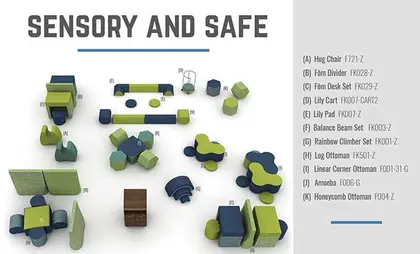
by David Jakes, Founder and Lead Designer, David Jakes Designs LLC
The return to school will mean many things. Most likely schools will assume a return to some type of normal, however they define normal. Classrooms will refill, students will restart their relationships with one another, and schools can get back to educating kids with the advantage of face-to-face interaction, so necessary for teaching and learning.
There is no doubt about the disruption caused by the 2020 pandemic. Undoubtedly, the challenges of the pandemic will be replaced by the challenge of what is next.
Educators, and others, have been reminded every day of the need for the human connection schools provide for their students. That connection in the past has been dependent upon the interactions of people in their physical space. In the future, it is likely these interactions will also need to occur in virtual spaces. Consequently, building more capable and adaptable learning spaces, both physical and virtual, should be a priority for schools, post-pandemic.
Building more capable and adaptable learning spaces, both physical and virtual, should be a priority for schools, post-pandemic.
To begin thinking about a strategy for improving your learning spaces in the future, consider the following six suggestions:
Re-value learning spaces as “the third teacher.” The Reggio Emilia approach to education defines three teachers of children: adults, peers, and space. This belief elevates the importance of space and the role it plays in the education of children. Partnering with manufacturers like Fōmcore who prioritize the value of adaptable spaces is a key component when addressing the importance of space as a teacher. The lightweight design of their pieces allows students to play an active role in the creation of their own learning environment. Moving forward, choosing to focus on the importance of learning spaces in the daily operation and routines of school and how they serve teaching and learning will be an important consideration for the post-pandemic school.
Spend time defining the new teaching and learning experience you want. Designing spaces that create compelling learning environments begins by identifying what the school wants learning to look like. This should be a critical question coming out of the pandemic schools must address. From these discussions, create a framework based on your vision for learning that can provide the foundation for designing new spaces. This will ensure spaces are specifically designed to support the expected student learning experience. Not forgetting about teachers and their needs will be important as they occupy the space too.
Place a greater focus on the development of human-centered spaces. Re-investing in learning spaces means establishing more human conditions associated with space. As part of a new mindset around learning spaces, ensure all students have equitable access to the spaces they need for learning. Make an effort to focus on the interaction of space design, health and wellness. Explore biophilic design and create spaces that connect people to the natural world. Get even more engagement in the learning spaces of your school by focusing on how furniture supports learning through comfort, improved posture, movement, and how it contributes to an irresistible invitation into learning. Fōmcore’s Daisy Set is a great example of how dynamic seating can transform a space. Students can separate the individual ottomans for breakout work and bring them back together for collaborative projects.
Develop a broader definition of what constitutes a learning space. Among the questions about teaching and learning that must be addressed is the role that virtual learning will play in education. Will schools support more blended conditions for learning or make an investment in online learning courses? In any case, the addition of effective virtual learning spaces will broaden the concept of what a learning space can be. Associated with the increased importance of virtual spaces is the influence they have on their physical space counterparts. An interesting question for schools to ponder is this: How do you design a physical space to support a more virtual learning experience?
Schools should consider adding spaces for making, tinkering, and fabrication as well as spaces that support entrepreneurial education.
Focus on new spatial typologies that bring new learning opportunities. In a broader concept of what constitutes school spaces, there are opportunities to consider new types of spaces for school. Schools should consider adding spaces for making, tinkering, and fabrication as well as spaces that support entrepreneurial education. The rise of E-sports is another type of activity that requires a specific space that can increase student engagement in school. Working with a manufacturer who can customize furniture to fit whatever your space needs will allow any space imagined come to life. Contact Fōmcore and hear more about their in-house space planning and custom capabilities.
Develop new partnerships to support your learning space work. The questions associated with space post-pandemic may be new for your school. Addressing them will require a significant effort to ensure spaces serve learning in the best way possible. Enlist trusted partners like Fōmcore to assist you in answering questions about learning spaces and their design. Fōmcore is dedicated to inspiring healthy, safe, and adaptable spaces for everyday life. From the conceptualization of a space to the final installation, they design products with the spatial needs for your working and learning environments in mind.
Moving forward, schools have a unique opportunity to rethink how they educate students. Most likely, that means keeping and improving what has worked, along with adding additional innovative approaches that support new conditions for teaching and learning. Both options include a consideration of how the spaces of schools serve teaching and learning. The six considerations described here can make this effort strategic and ensure your work improving your learning spaces is as effective as possible.